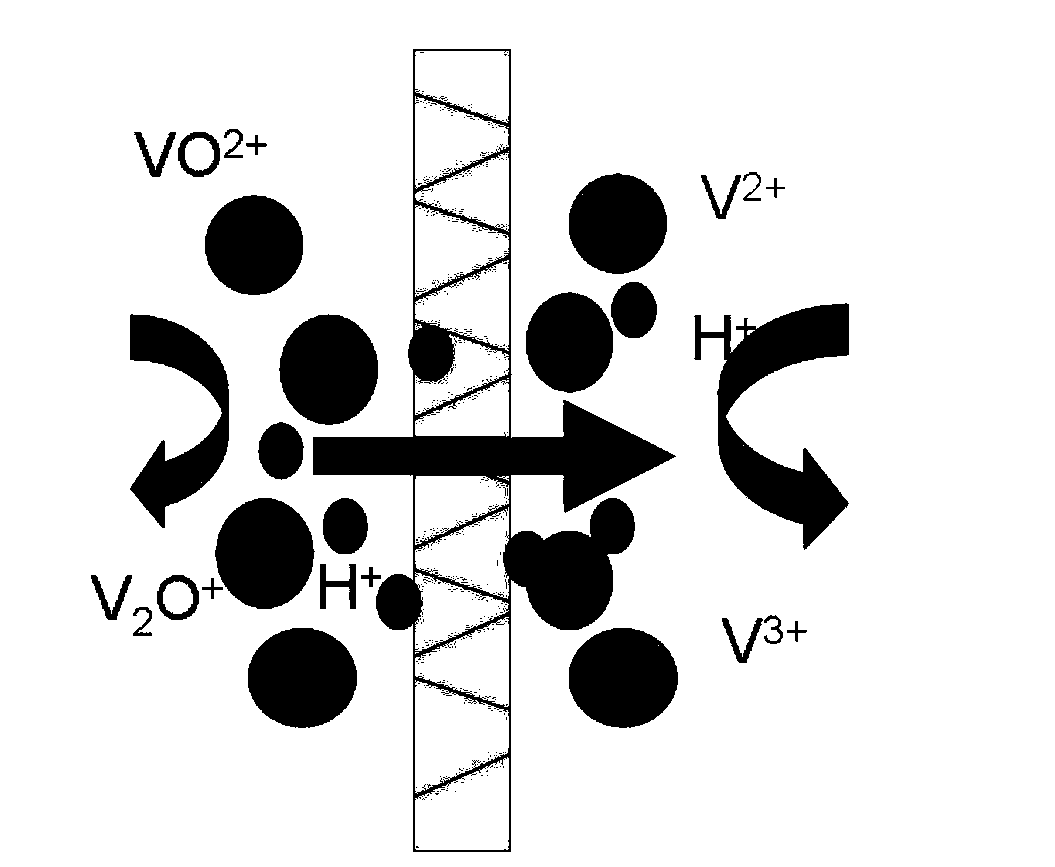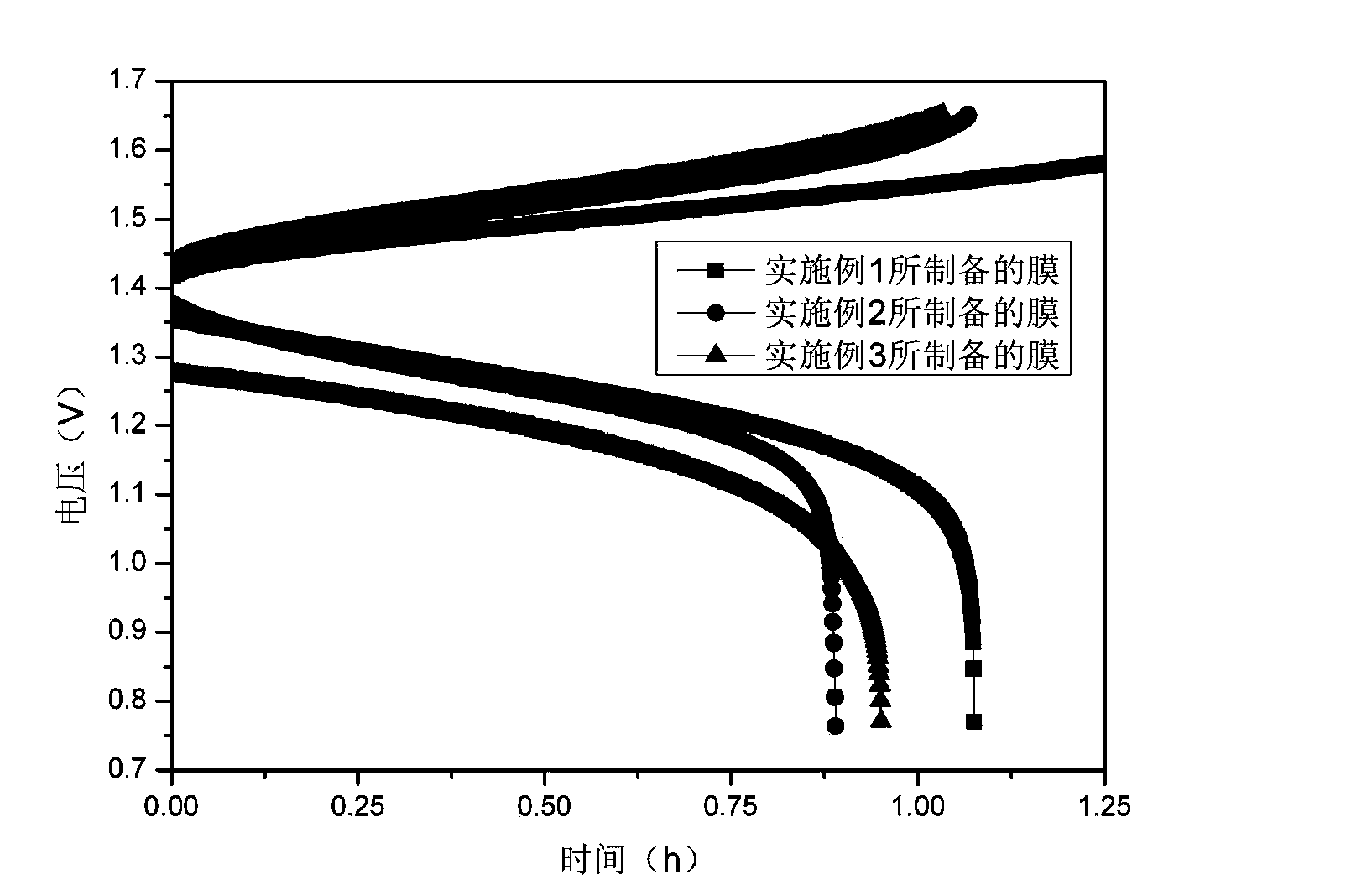Application of polymer porous separation membrane in liquid flow energy storage battery
A liquid flow energy storage battery and porous separation membrane technology, which is applied to fuel cell parts, fuel cells, battery pack parts, etc., can solve the problem that polyvinylidene fluoride membranes cannot be used as ion exchange membranes and reduce polymer performance and other problems, to avoid the reduction of polymer oxidation stability, to achieve the effect of controllability and excellent mechanical stability
- Summary
- Abstract
- Description
- Claims
- Application Information
AI Technical Summary
Problems solved by technology
Method used
Image
Examples
Embodiment 1
[0032] 1.8 grams of polyvinylidene fluoride with a molecular weight of 50,000 was dissolved in 10ml of DMAC, stirred for 12 hours, and the resulting polymer solution was spread on a glass plate, then quickly immersed in 5L of water, solidified, and formed a porous separation membrane. The structure of the membrane is a typical asymmetric porous membrane, which consists of a dense skin layer and a macroporous support layer. The pore diameter of the membrane skin is about 50nm, the porosity is 70%, and the thickness is 70 microns.
[0033] The all-vanadium redox flow battery is assembled by using the prepared porous separation membrane, the activated carbon felt is the catalytic layer, the graphite plate is the bipolar plate, and the effective area of the membrane is 9cm -2 , with a current density of 80mA cm -2 , the vanadium ion concentration in the electrolyte is 1.50mol L -1 , H 2 SO 4 The concentration is 3mol L -1 . The assembled flow battery has a current efficien...
Embodiment 2
[0035] 2.1 g of polyvinylidene fluoride was dissolved in 10 ml of DMAC, stirred for 12 hours, and the formed polymer solution was spread on a glass plate, and then quickly immersed in 5 L of water to solidify to form a porous separation membrane. The pore size of the membrane skin is about 40nm, the porosity is 75%, and the thickness is 70 microns.
[0036] The all-vanadium redox flow battery is assembled by using the prepared porous separation membrane, the activated carbon felt is the catalytic layer, the graphite plate is the bipolar plate, and the effective area of the membrane is 9cm -2 , with a current density of 80mA cm -2 , the vanadium ion concentration in the electrolyte is 1.50mol L -1 , H 2 SO 4 The concentration is 3mol L -1 . The assembled flow battery has a current efficiency of 92.1%, a voltage efficiency of 86.2%, and an energy efficiency of 79.4%.
Embodiment 3
[0038] Dissolve 2.3 g of polyvinylidene fluoride in 10 ml of DMAC, stir for 12 hours, spread the resulting polymer solution on a glass plate, then quickly immerse in 5 L of water, solidify, and form a porous separation membrane. The pore size of the membrane skin is about 30nm, the porosity is 80%, and the thickness is 70 microns.
[0039] The all-vanadium redox flow battery is assembled by using the prepared porous separation membrane, the activated carbon felt is the catalytic layer, the graphite plate is the bipolar plate, and the effective area of the membrane is 9cm -2 , with a current density of 80mA cm -2 , the vanadium ion concentration in the electrolyte is 1.50mol L -1 , H 2 SO 4 The concentration is 3mol L -1 . The assembled flow battery has a current efficiency of 96.8%, a voltage efficiency of 74.5%, and an energy efficiency of 72.1%. It can be seen that in Examples 1-3, as the membrane pore size decreases, the coulombic efficiency of the battery increases...
PUM
| Property | Measurement | Unit |
|---|---|---|
| Aperture | aaaaa | aaaaa |
| Film thickness | aaaaa | aaaaa |
| Aperture | aaaaa | aaaaa |
Abstract
Description
Claims
Application Information
 Login to View More
Login to View More - R&D
- Intellectual Property
- Life Sciences
- Materials
- Tech Scout
- Unparalleled Data Quality
- Higher Quality Content
- 60% Fewer Hallucinations
Browse by: Latest US Patents, China's latest patents, Technical Efficacy Thesaurus, Application Domain, Technology Topic, Popular Technical Reports.
© 2025 PatSnap. All rights reserved.Legal|Privacy policy|Modern Slavery Act Transparency Statement|Sitemap|About US| Contact US: help@patsnap.com


